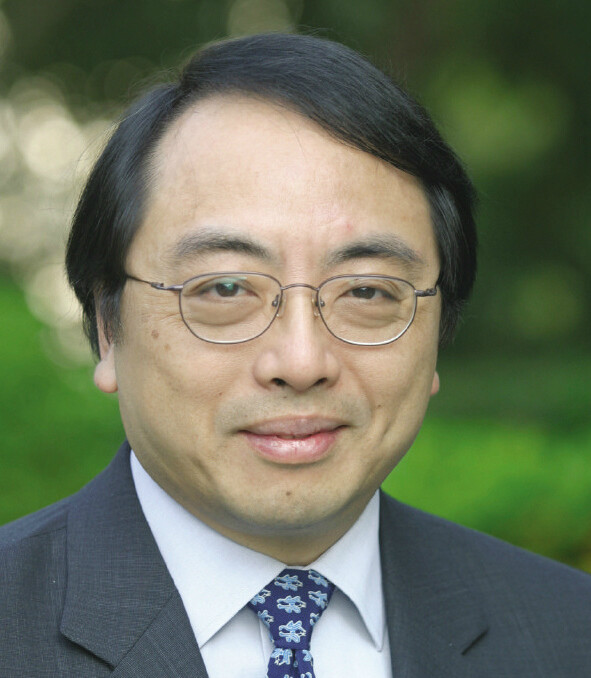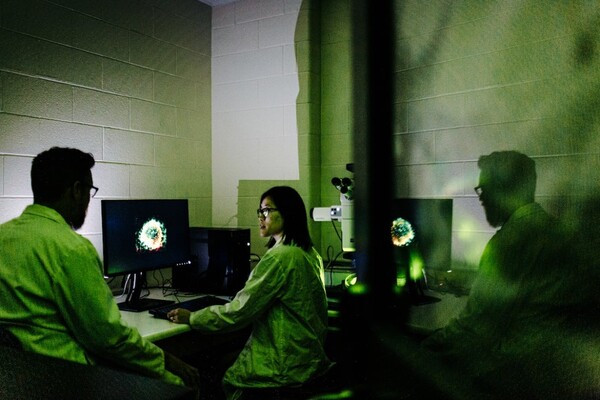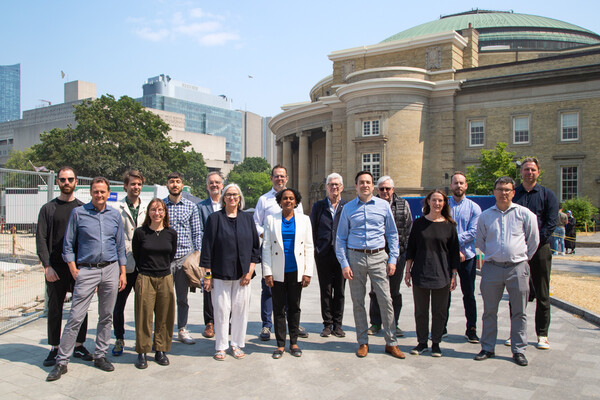Honouring Professor Lap-Chee Tsui, Awardee of the 2014 Henry G. Friesen International Prize in Health Research

On September 18, the members of the Canadian Academy of Health Sciences honoured Professor Lap-Chee Tsui at their annual luncheon as the 2014 recipient of the Henry G. Friesen International Prize in Health Research. Established by the Friends of CIHR in 2005, this award honours Dr. Henry Friesen and his distinguished leadership, vision and innovative contributions to health research. The recipients must be Canadian and recognized internationally for their outstanding leadership and health research contributions.
This year, to the delight of our colleagues in the Faculty of Medicine and at the Hospital for Sick Children, Professor Lap-Chee Tsui received this prestigious award on the 25th year following his incredible discovery of the cystic fibrosis gene. Lap-Chee is one of our most distinguished emeritus professors. Before leaving to assume the position of Vice-Chancellor and President of the University of Hong Kong in 2006, he was recognized as a Gairdner Award recipient and a University Professor (our highest rank) at U of T. When the Donnelly Centre opened in 2005 we celebrated Professor Lap-Chee Tsui as one of the 10 U of T “giants” in health research — a group which also included Banting and Best.
Professor Lap-Chee Tsui’s address to the Canadian Academy of Health Sciences focused on his life story and what he has learned from his experiences. He graciously agreed to share this narrative with his former colleagues in the Faculty of Medicine. Those of us from U of T who heard it first-hand thought his message would resonate with our faculty and students. Thanks so much, Lap-Chee for allowing us to publish your words of wisdom … and please accept our most heartfelt congratulations on receiving the Friesen Prize this year.
Catharine Whiteside
Dean, Faculty of Medicine
Vice-Provost, Relations with Health Care Institutions
A Formula for Success — Right Time, Right Place and Right People
A speech by Prof. Lap-Chee Tsui
May I begin by thanking the Friends of CIHR for bestowing the highly prestigious Henry G. Friesen International Prize in Health Research and giving me the opportunity to come to Ottawa for the past two days. I should also acknowledge the sponsorship of CAHS of the Prize. I am tremendously honoured by the Prize, which does not only recognize my contribution to health research, but also all those people who worked or collaborated with me throughout my research career.
As I was asked to share my work experience with you, it made me begin to think that perhaps it was my ability to catch opportunities as they arose; perhaps it was my work style that attracted like-minded people; or perhaps I was simply lucky; somehow I manage to be in the right place, at the right time, and surrounded by the right people.
Let me elaborate:
I liked geometry and sketching ever since my school days. So, I grew up very much wanting to be an architect but ended up in biomedical research and later even became a university president. If you happen to know my academic performance in my school days, you would probably never bet on the odds that I would be standing in front of you here this afternoon.
1: Getting into college
First of all, I almost did not get into college. For reasons that I am not going to elaborate here, I did not perform very well in examinations. So when I was applying to college, I only received an invitation to interview by the Department of Biology of New Asia College, part of the Chinese University of Hong Kong, on the second day! The intake was around 20 students, and so my chance of getting in was probably slim. So, instead of sitting at home, I decided to show up during the lunch hour on day one, and, miraculously, I found the Department Head in the corridor. I went up to him and presented myself.
Thinking about it years later, presenting to the department head, how many prospective students could identify the head of a department of a small college, especially as this was long before internet was available? I concluded that he was impressed.
Well, the department head went inside the interview room for a short while and came out to tell me to return tomorrow. From the tone he spoke and the look on his face, I had a very good feeling. The next day, when I went into the same room, I was not asked a single question in the interview that was supposed to last for 15 minutes, and I was sent over to see the Registrar for the rest of the formalities. Later, I discovered that I had the highest mark on the prerequisite biology paper; perhaps it was my drawing skills that helped.
Moral of the story: I was not afraid to ask difficult questions, but in advance found it important to prepare ahead of time to be ready to answer questions.
2: Going to seminars.
I love to learn new things. I enjoy listening to others on foreign subjects. However, when I take notes during seminars, it’s not only that my handwriting is not entirely legible, and the notes often do not agree with what the speaker is talking about; instead, my notes would be on how I could adapt the approach or borrow the ideas. So, for years, although I love going to seminars and talks, I could never explain exactly what the speaker talked about after the seminar.
This one time in early 1974, I attended a seminar given by a professor from Pittsburgh while I was a graduate student doing my master’s degree in Hong Kong. The speaker was Chien Ho. His topic was about his NMR study on the structure of haemoglobin. To be honest, I am not sure anyone in the audience, of course myself included, knew what he was talking about because Chien was really at the frontier of structural NMR studies then. In any case, I was a good student and stayed until the end. I even asked a question but I have no idea what it was.
Later, we were asked to join a discussion session with the speaker. He was interested in hearing our research projects. It was my turn and I talked about my work on lambda phage. His eyes lit up and he told me that his department recently recruited someone by the name of Roger Hendrix who also happened to work on lambda phage. He asked me to give him my CV. I got an offer for further research training very soon, even a very handsome stipend.
In fact, a lot of the ideas for my dissertation work came from attending seminars.
Moral of the story: I was always prepared to learn new things. I guess that is what we call life-long learning.
3: Pittsburgh Folk Festival:
There were about 300 students of Chinese ethnicity studying in Pittsburgh at the time, in the 70’s; not just at the University of Pittsburgh, but also Carnegie-Mellon University, and a number of other smaller colleges. For some reason, which I will again skip here, I was elected to be the President of the University Chinese Club there, and, we were invited by the Foreign Student Office to take a booth at the annual Pittsburgh Folk Festival that year.
To me, it was a simple project. What we decided to do was to sell eggrolls there and we managed to get a Chinese restaurant to be our sponsor. The restaurant provided the materials for free and we made some 2,000 eggrolls from scratch. The trick of the trade was to pre-fry them and refry them on site using our camping stoves and pots. We thought that should last the whole weekend. To everyone’s great surprise, we sold every single eggroll on Saturday morning. We did not even get to eat any ourselves.
Then, being there and having nothing to do, I decided to walk around the fairground to look at displays from other countries. Soon, I ran into a group of young oriental kids who were trying to erect a booth with a bunch of 2x4’s and plywood boards. It turned out they were asked by their parents to build the booth for the Organization of Chinese Americans. So I decided to stop and helped them finish constructing their booth. The Samaritan act impressed an older gentleman, who was the president of the Pittsburgh Chapter, Han Chang.
Later, we became very close and he taught me a lot about how to survive in America; he told me that pure Chinese way would not work in the U.S. One of the analogies he used was the Coca Cola commercial at that time, which said: Coke is the Real Thing. You have to keep reminding people that even you are the real thing. This is very different from the Chinese culture, which teaches people to be modest and humble; we should wait for other people to discover our talents. Obviously, this is not the way it works in America.
I learned a lot from Han and, to this day, I am still extremely grateful to him for his advice and guidance.
Moral of the story: While I was ready to contribute without thinking of the return, I was ready to learn to adapt to new culture and environments.
4: Cystic Fibrosis research
I came to Canada in January 1981 to join Manual Buchwald and Jack Riordan’s lab to try to figure out the basic defect in cystic fibrosis (CF), a fatal genetic disease affecting quite a large part of the Canadian population.
My lab was one of the few that were set out to do CF disease gene mapping studies. In the past two days, I told the story that I was able to get my first grant from the Canadian Cystic Fibrosis Foundation (now CF Canada) because the grant review panel decided to take a chance on this novel method because they could not really assess my proposal at the time.
As you all know, the successful identification of the CF gene was a 3-way collaboration between my lab, that of Jack Riordan in the Department of Biochemistry in the same hospital research institute and, that of Francis Collins, in Ann Arbor, Michigan. Jack provided the most important part of our study — the sweat gland cDNA libraries, and, Francis, the chromosome jumping technology. Also, I must mention the work of Aravinda Charchrarti because he was the one who checked all our linkage calculation. When he produced a p-value of 10-57, no one could argue with our conclusion.
I should also say that there was quite a bit of data sharing before publication. I found some of the correspondence when I was cleaning my boxes of documents just recently. You may remember the false alarm of the cloning of the CF gene reported by Bob Williamson’s group in London. He was perhaps overly confident about their candidate gene at that time. However, he was quick to admit that he was wrong, so that our funding would not be cut off by our funding agencies. I still remember that the NIH Study Section had already returned the priority scores to their Council and it was the Council that reversed the decisions after Williamson made his public admission. I respect Bob’s integrity and courage. We became good friends later.
After the cloning of the gene, we shared the DNA sequence of the gene as the exon-intron structure of the gene was still being worked out in our laboratory, so that others could use the information to identify the mutations in their patients. We also decided to form a genetic analysis consortium to share data before publication, so that we would not duplicate efforts. I am glad we did that because, up to this day, more than 1,900 CFTR mutations have been reported. Keeping the database was obviously an important volunteer job among collaborators.
Moral of the story?
When you were the first to identify a disease gene the way we did and the method became a popular one, you were naturally riding in front of the wave. You don’t have to work very hard to propel yourself because you are being pushed. So, timing is everything.
Bob’s decision to announce his mistakes was also timely. However, I always use the story for my talk to students to stress the importance of integrity and honesty in science.
5: Moving to Hong Kong
A lot of people were surprised that I decided to leave my research career to take on a management position at the University of Hong Kong (HKU). I am not going to tell you all the reasons today but I can say that I was actually quite intrigued by the idea of returning to Hong Kong at that time, particularly to serve the oldest university in the region. I must say, however, HKU was not the first to approach me and I was not the first they approached.
I can also tell you that Victor Fung, Council Chairman of the University, did spend some time trying to convince me. The most vivid thing I remember was his view of the window of opportunity. What he did not tell me in our conversations was that he actually told members of the university that he would see HKU getting to be in the top 25 of universities in the world. Fortunately, there were no world university rankings then; later, when there were rankings, HKU once even got ranked #18, even above Stanford! So, like Olympic Gold Medals, once you get a Gold Medal, you become Gold Medalist for life!
Kidding aside, I must admit that I have made quite a number of improvements over my 12 years of tenure as the Vice Chancellor and President there. University ranking was not one of them. I actually developed the first strategic plan for the university in its close-to-a century’s existence, and among the list of strategies, I think “building a cohesive university family of staff, students, alumni and friends” was probably the best thing I did there.
Last week; an alumna raised a question after my talk at the Canadian Chamber of Commerce in Hong Kong, asking me to name the 3 most important things that I did to raise HKU’s profile and reputation today. My answer: people, people, people!
Basically, I am not an ambitious person; it is perhaps my instinct of spotting opportunities and care for details that made me successful as a lab researcher and later, my belief in teamwork, the importance of communication, and ability to work with a very capable group of people around me, that helped me build a strong university.
Karma
I am not religious. However, I believe in karma — you reap what you sow; cause and consequence form a virtuous circle — I believe in doing good deeds; however, I never anticipate any rewards for anything I do — because the return would come naturally and, most often, in an unanticipated way.
Speaking on karma, I must say that my life is full of circles. Some of the half circles ended up to be perfect circles later; for example:
The biomolecules I studied: lambda phage has a circular piece of DNA, the head capsid is an icosahedron; its tail has radial symmetries; the bacterial gene product that is essential for the assembly of the phage particle — groE has a 7-fold symmetry
- The product of the cystic fibrosis gene, CFTR, is a chloride channel — even though I have not studied its 3-D structure carefully, it must have a hole or a circle to let the chloride ion flow through the cell membrane.
- I traveled from east to west to pursue my research training and later a long stay at the SickKids; and then I returned from Toronto to Hong Kong to become the President of the University of Hong Kong;
- I can give more and more examples.
But, do I have a formula for success? I think the only commonality is:
Right time, right place, and right people
or just serendipity
Thank you very much for allowing me to share with you some of my self-analysis.
News


